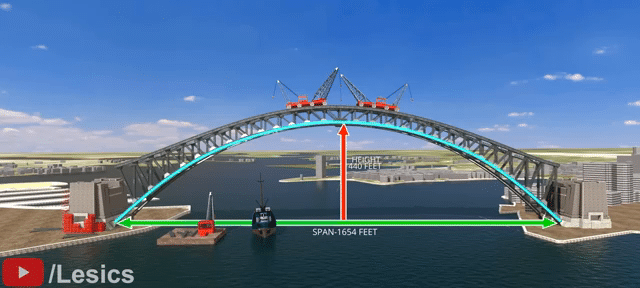Engineering Marvel: The Parabolic Arch and Pioneering Techniques of Sydney Harbor Bridge Construction
Home » Engineering »
The Marvel of Sydney Harbor Arch Bridge
Today, tourists marvel at the majestic Sydney Harbor Bridge, a pinnacle of engineering perched over the bustling harbor. Yet, nearly a century ago, a critical moment in its construction unfolded—a day marked by intense winds and high stakes. Construction workers faced the daunting task of joining the two halves of the bridge’s steel arch, knowing it was their only chance to complete the structure in such challenging conditions. This feat was not just a triumph of timing but also of engineering, as the arch needed to support substantial loads, including train traffic, marking a significant achievement in architectural design.
The bridge’s elegant curve is a key to its strength and stability. Unlike a circular arch, which would likely succumb to the forces acting upon it, the Sydney Harbor Bridge was designed with a parabolic arch. This form is ideal as it distributes weight and stress evenly throughout the arch, a critical factor in the design of such large-scale structures. The arch itself supports the road deck through vertical hangers, making it a through arch bridge, where the deck is situated below the top of the arch, allowing unobstructed movement for ships passing underneath.
Understanding Arch Stability and Design
The stability of an arch bridge, like that of the Sydney Harbor, lies in its ability to transfer loads efficiently. The shape of the arch plays a crucial role here. In an experiment comparing different arch shapes under weight, a parabolic arch proves to be the most effective in bearing loads without collapsing. This shape forms naturally when a chain hangs freely between two points, assuming a form known as a catenary curve, which is then inverted to form a parabolic arch in structures.
During construction, the bridge’s arch was built from both ends simultaneously, meeting at the center. This method required precise calculation and adjustments, ensuring that the two halves aligned perfectly at the join. Temporary cables supported the half-arches during construction, preventing them from succumbing to gravity. Once the arches were joined, these supports were gradually removed, allowing the arch to bear its full weight. This critical moment not only tested the arch’s design but also demonstrated the effectiveness of the parabolic shape in distributing the structural loads.
Innovative Construction Techniques
The construction of the Sydney Harbor Bridge utilized groundbreaking techniques and logistics. Massive steel sections of the arch were transported by pontoon boats to the site, where they were then lifted by cranes into place. Initially, these pieces were held together by bolts. Once the precise alignment was achieved, they were permanently joined using rivets, with an astounding six million rivets used throughout the bridge. This meticulous process ensured that each section of the bridge was securely fastened, enhancing the overall structural integrity of the arch.
Upon nearing completion, engineers faced the challenge of the final closure of the arch. The last gap closed naturally as the support cables were incrementally released, relying on the weight of the arch itself to bring the two halves into contact. This precise operation underscored the accuracy required in the engineering calculations and the construction methods employed.
Thermal Expansion and Structural Integrity
The Sydney Harbor Bridge is designed to accommodate natural thermal expansion and contraction. Engineers included massive bearing hinges at the base of the arches, which allow the structure to flex in response to temperature changes. During warmer months, the metal expands, and these hinges adjust the angle of the arch accordingly, preventing any stress accumulation that could compromise the bridge’s structural integrity. This ingenious solution highlights the attention to detail that has gone into every aspect of the bridge’s design and construction.
Furthermore, the layout of the bridge supports a diverse mix of traffic. The road deck includes lanes for vehicle traffic, train tracks, and pedestrian pathways, illustrating the multi-functional design of modern arch bridges. This design not only meets various transportation needs but also ensures the stability and longevity of the bridge under different types of loads, from daily traffic to the dynamic forces exerted by trains.
Architectural and Engineering Significance
The Sydney Harbor Bridge stands as a testament to the ingenuity of its designers and the skill of its builders. It embodies the principles of parabolic arch design, demonstrating how functionality and aesthetic appeal can coexist. The bridge not only connects points across the harbor but also stands as a symbol of architectural beauty and engineering prowess. Its construction is a lesson in precision and planning, providing insights into the complexities of large-scale architectural projects. As visitors walk, drive, or ride trains across this iconic structure, they experience a piece of engineering history that continues to inspire and amaze.
The Sydney Harbor Bridge’s story is a compelling chapter in the history of structural engineering, highlighting the evolution of construction techniques and materials. Its successful completion despite potential obstacles is a reminder of the possibilities within civil engineering to overcome natural challenges through innovation and determination. As the bridge continues to function as a vital artery in Sydney’s infrastructure, it also stands as a monument to human ingenuity and the relentless pursuit of architectural excellence.










